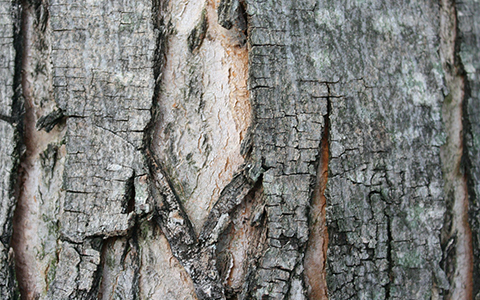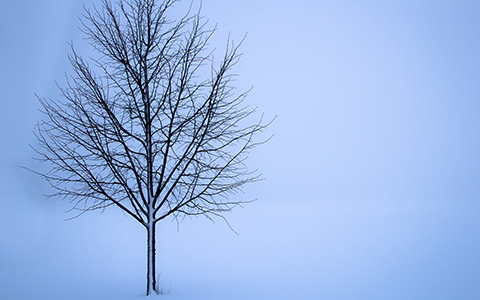Notice: Undefined variable: page in /home/vrxdg1855sn3/public_html/wp-content/themes/72tree/content.php on line 15
Notice: Trying to get property 'ID' of non-object in /home/vrxdg1855sn3/public_html/wp-content/themes/72tree/content.php on line 15
Crack In Your Tree Trunk?

Have you noticed cracks and splitting in the trunk of your tree? Is your foliage located in a spot with exposure to frigid winters? If so, it could be a frost crack! These appear as a vertical crack along the trunk of your tree. This damage can be dangerous to a tree because it is severe enough to split through the tree.
Luckily, with a few extra care steps throughout the year, you can prevent these and help your trees stay healthy and in one piece! Read on for advice on how to prevent and treat frost cracks.
Frost Crack Causes
These vertical cracks form when a tree trunk is exposed to extreme changes in temperature between winter and summer. The repeated heating and cooling can cause the molecules to slightly expand and contract just enough that a bark crack can form as a reaction to the extreme changes. Below are ways of helping your tree survive the winter months.
Reversing the Damage
If you notice the cracking, should you do anything about it? Not necessarily, because in most cases, the tree will be able to recover on its own through the natural processes of healing.
However, you can help it recover, and prevent a split trunk, by sealing the crack with plastic. The plastic seal protects the opening from potential infections caused by bacteria and pests. Be careful, though! You should remove any wrapping you place on the tree before summer. Otherwise, it may foster infections instead of preventing them.
Frost Crack Prevention Methods
Insulation – Because frost cracks arise from the changing temperature, you can help prevent the tree trunk from cracking by insulating the base.
Insulation includes wrapping the trunk with a thick protective layer. Ideally, you’d want to use something that would keep warmth, like a tarp, burlap, or cloth.
You can also help insulate your tree’s trunk by planting evergreen plants and bushes around the base. Keeping the bottom of the tree lush with plants and bushes will help keep it warm during the winter and prevent deep freezing.
Keep Trees Healthy – A healthy and vigorous tree will be more capable of healing after a crack and more resistant to bark cracking in the first place. Read on to learn ways to keep your foliage healthy.
Every summer, make sure you give the soil a fresh layer of fertilized dirt to mix into the already present substrate. On top of that, layer some mulch or bark pieces to help pack in the new soil. This mulch technique will also work as a form of insulation during the wintertime.
Watering your tree during dry winter periods is very important too. Even when it’s cold out, your foliage will need to have an ample water supply to stay healthy.
Pruning or trimming the foliage can also encourage it to sprout new healthy growth, improving its overall health status. However, you should hire a professional, as it can be dangerous to do it on your own.
Be Careful Where You Put Your Tree – Location plays a massive role in the health of your foliage during wintertime! To avoid having a split trunk, be careful that your tree is not exposed to strong winter winds because this will cause the bark to become even colder and has a higher chance of cracking.

Shallow and porous soil/substrate is a bad idea because of how important hydration is for your foliage in winter. Stick to locations where the tree’s roots can extend very far downward for more support and a healthier root system.
Choosing a location with a proven water-retaining soil system always works best. These locations already help your tree stay healthy enough to avoid cracks and heal any cracks that it may have in the future!
Trees Prone to Frost Cracks
Like all organisms, trees have adapted to survive in various climates. Some have adapted better than others to areas with intense winters and are less likely to experience a split trunk.
If you are undecided on what tree species to use, here are a few that are less resistant to winters and more likely to experience bark cracks:
• linden
• sycamore
• oak
• walnut
• willow
• maple
As a rule of thumb, the thinner the bark on the tree, the less resistant it is to cracks. In cold climates, choose trees with thick bark like aspens!
Final Thoughts
Frost cracks result from trees going through extreme cold and heat. The slight expansion and contraction of the molecules inside the tree result in the bark cracking on the surface of the tree.
If you see this happening, it is good to prevent infections and pest infestations by wrapping them in plastic. Consider insulating your tree trunk with either burlap, a tarp, or evergreen shrubbery to avoid cracking in general. Keep your tree healthy by fertilizing, watering, pruning, and adding a mulch layer.
If you keep these tips in mind when placing and taking care of your tree, you will be set for it to resist vertical cracks even in the harshest winters!
